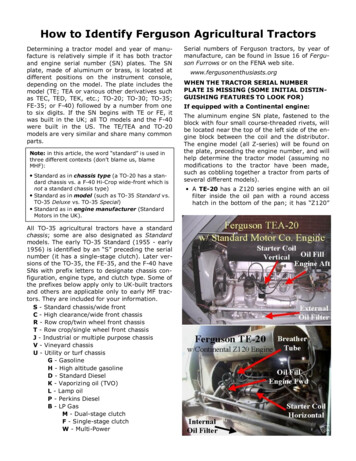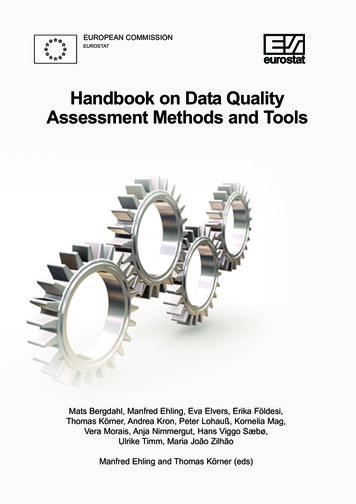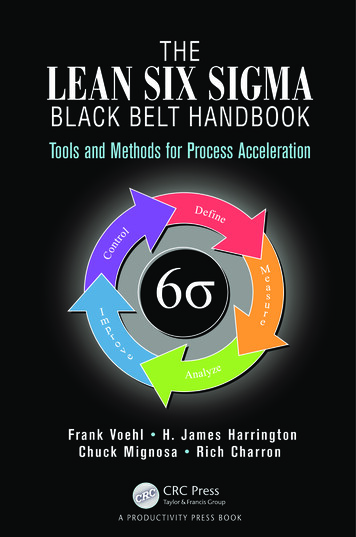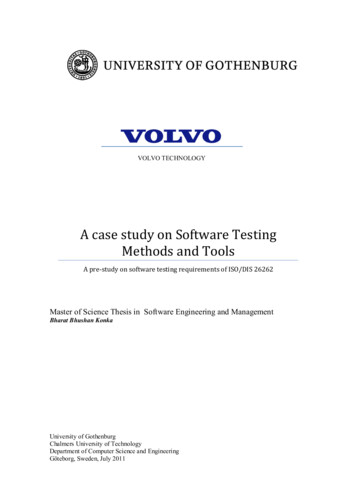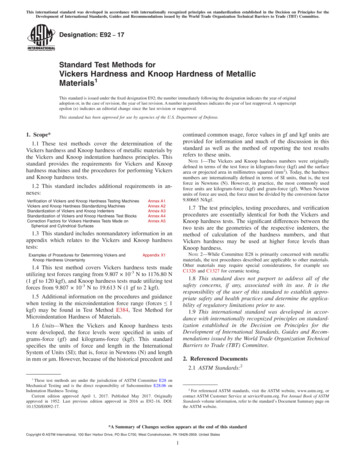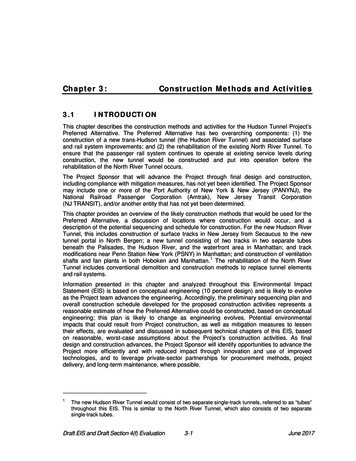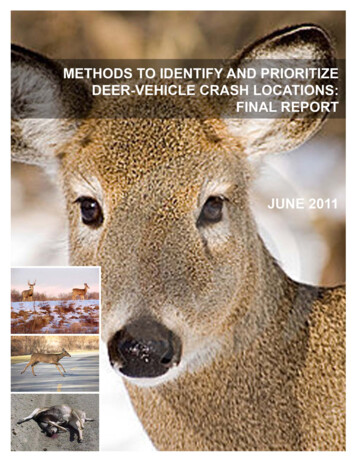
Transcription
METHODS TO IDENTIFY AND PRIORITIZE DEERVEHICLE CRASH LOCATIONS – FINAL REPORTPrepared forThe Federal Highway Administration1200 New Jersey Avenue, SE.Washington, D.C 20590Prepared byNORMANDEAU ASSOCIATES, INC.25 Nashua RoadBedford, NH 03110R-19977.002June 2011
Task 4 Final ReportTABLE OF CONTENTSTable of Contents . iiList of Appendix C Figures. ivList of Tables. v1.0Introduction. 12.0Background. 23.0Summary of Current Practice. 34.0Assessment Methods to Identify Hotspots. 65.0Data . 75.1 Data Sources . 75.2 Data Processing . 76.0Methods . 86.1 Clustered or not Clustered?. 86.1.1 Nearest Neighbor. 86.1.2 Moran’s I . 96.2 Where are the Hotspots?. 96.2.1 Visual Analysis. 106.2.2 Density-Based Analysis . 116.2.3 Modeling . 126.2.4 Spatial Statistics . 136.2.5 Expert Opinion . 147.0Results. 157.1 Iowa I-35 . 167.2 Iowa Route 65. 177.3 New York I-90 . 187.4 New York Route 28. 198.0Comparison of Methods . 208.1 Underlying Distribution. 208.2 Hotspot Methods. 208.3 Choosing a Method. 239.0Predicting DVC Locations . 2410.0Conclusion and Recommendations . 2511.0References . 26Appendix A – Literature Review. 11.0Introduction. A-52.0Identifying DVC Hotspots . A-52.1 Non-Quantitative Methods . A-62.3 Traditional Statistics. A-82.3 Spatial Statistics . A-9iiNormandeau Associates, Inc.
Task 4 Final Report3.0Methods to Examine the Relationship of DVCs to Roadwayand Environmental Factors . A-94.0Factors Associated with DVC Hot Spots. A-105.0Predicting DVC Locations . A-126.0Sources of Data for DVC Analysis . A-137.0Literature Cited . A-15Literature Review: Appendix A . A-17Cited References Summarized in Tabular Format by Topic Area. A-17Appendix B – Summary of Current Practices. B-1Questions Asked During Interviews of Dot Safety and Environmental Personnel . B-5Appendix C - Figures . C-1iiiNormandeau Associates, Inc.
Task 4 Final ReportLIST OF APPENDIX C FIGURESAppendix Figure C-1.Iowa Locus Map. C-2Appendix Figure C-2.New York Locus Map. . C-3Appendix Figure C-3.Comparison of map types for visual analysis. . C-4Appendix Figure C-4.Density Based Analysis – comparing thresholds based on meanDVC/mile to identify hotspots, IA Rt 65. C-5Appendix Figure C-5.Route 65 hotspots identified using a binomial model (95% CI) and athree-mile moving window based on the binomial model. . C-6Appendix Figure C-6.CrimeStat Results – Route 65, illustrating variation in results based onnumber of DVC considered and size of search radius used. A colorcoded visual analysis map is provided for comparison. . C-7Appendix Figure C-7.Data (map) used for the expert analysis, Iowa Route 65. C-8Appendix Figure C-8.Iowa I-35 Results. Figure 8a segments are labeled by DVC count; allothers are labeled by segment number. . C-9Appendix Figure C-9.Iowa Route 65 Results. 9a segments are labeled by DVC count; allothers are labeled by segment number. . C-10Appendix Figure C-10. New York I-90 Results. 10a segments are labeled by DVC count; allothers are labeled by segment number. . C-11Appendix Figure C-11. NY Route 28 Result. 11a segments are labeled by DVC count; allothers are labeled by segment number. . C-12ivNormandeau Associates, Inc.
Task 4 Final ReportLIST OF TABLESTable 1.Summary of interview results relating to analysis of DVC hotspots. States aresorted by name of the DOT branch that conducts DVC hotspot analysis. 5Table 2.Hotspot analysis methods assessed under Task 4. 6Table 3.Summary of data from each study area. . 7Table 4.Data needs and software used for each assessment method considered. .10Table 5.Number and proportion of segments identified as hotspots by each method.15Table 6.Overlap of segments identified as hotspots.15Table 7.Comparison of analysis methods assessed under Task 4. .22vNormandeau Associates, Inc.
Task 4 Final Report1.0 INTRODUCTIONThe Deer-Vehicle Crash Information and Research (DVCIR) Center is amulti-state pooled fund project which also includes the Federal HighwayAdministration (FHWA) as the lead agency. The State Departments ofTransportation (DOTs) that fund the DVCIR Center activities areConnecticut, Iowa, Maryland, Minnesota, New Hampshire, New York,Ohio, Texas, and Wisconsin. In order to fill methodological knowledgegaps, the DVCIR commissioned the Investigation of Methods toIdentify and Prioritize Deer-Vehicle Crash Locations of Concern. Theover arching goal of the project is to help participating states evaluateand advance their deer vehicle crash (DVC)-related safety managementsystem. To meet this goal, the main objectives of the investigation wereto: Document and evaluate the existing crash analysis approaches,capabilities, and/or DVC-related databases of participatingpooled fund states along with the “best practices” in thesesubject areas from throughout the United States, including anyexamples of DOT safety programs that systematicallycombined the use of roadway and land characteristic databasesin their decision-making. Summarize the different approaches and tools that could beused to identify and prioritize DVC hot spot locations andanalyze DVC data.OBJECTIVES Document and evaluate theexisting crash analysisapproaches, capabilities, and/orDVC-related databases alongwith best practices Summarize the differentapproaches and tools Evaluate the application ofseveral selection/prioritizationmethodologiesDEFINEDDVC Hotspots: Locations whereDVC are the most intenselyclustered or where more DVCsoccur than are expected bychance . Evaluate the application of several selection/prioritizationmethodologies at case study locations and describe their advantages and disadvantages.Additionally, the DVCIR was interested in the use of the identified methodologies and tools for predictivepurposes. The typical approach to “hot spot” location identification is reactive in nature, i.e., crashes need tooccur and be recorded before improvement. Examining the available analysis methods for use in aprediction/modeling or pro-active identification of new roadway segments that have the potential to be DVC hotspots is also in issue of interest.To meet the main objectives of the project, the investigation was broken into three primary tasks: Literature review – the primary goal of this task was to identify the full range of methods available toidentify DVC hotspots. Additionally, the literature was examined to identify variables associated withDVC hotspots and any methods currently used to predict likely DVC hotspots, based on theirassociation with these variables. Survey Current practice – personnel from 24 DOTs were interviewed to identify the most common,as well as the range, of methods currently used to identify general vehicle crash and DVC hotspots forsafety purposes. Additionally, interviewees were asked about data sets used to supplement and/orconfirm non-roadway factors believed to impact DVCs, and if they were aware of any current practicesdocumented to reduce DVCs and/or improve the efficiency and quality of DVC data collection. Evaluate Methods and Tools – the goal of this task was to evaluate the advantages and disadvantagesof methods currently available for use by state DOTs to locate and prioritize DVC hotspots, using adesktop analysis based on existing DVC data.The third objective of the investigation is the main focus of this report. Results of the literature review arehowever incorporated in to the methodological assessment to provide context to the assessment decisions, and abrief overview of the current practice survey is also included. The complete results of these two tasks areprovided in Appendices.1Normandeau Associates, Inc.
Task 4 Final Report2.0 BACKGROUNDIn many states DVCs are significant in number and widespread. Likeother types of crashes, however, there are often particular roadwaysegments where clusters or “hot spots” of DVCs occur. These roadwaysegments need to be properly identified and prioritized in a systematicmanner for effective and efficient implementation of potential DVCcountermeasures. This is especially true because the area- or systemwide implementation of current DVC countermeasures is not generallyconsidered to be economically feasible.DVC hotspots can be indentified using the methods that safetypersonnel use to identify locations where an excessive number of alltypes of crashes occur over time. DOT safety personnel havetraditionally used density measures based on standard distributions,sometimes in combination with a sliding windows approach, to identifycrash hotspots. However, this approach is prone to error, due to theinherent variability and non-normalcy of crash data (Persuad, 2001).Ecologists studying the interactions of deer with highways have alsoemployed a variety of methods to identify DVC hotspots (Appendix A),some of which are the same or similar as those used by safety personnel,and some of which are novel. However, they have not generally usedstatistically rigorous or mathematically appropriate approaches toidentify hotspots either. An additional issue that is also rarely addressedby either safety personnel or ecological researchers, is how best to chosethe values of the user-specified criteria that are part of any analysisprocess. “User-specified criteria” include decisions about study area sizeand thresholds for a hotspot to be considered significant.THE CHALLENGEDVC “hotspots” need to beproperly identified and prioritizedin a systematic manner foreffective and efficientimplementation of potential DVCcountermeasures.CURRENTLY DOT safety personnel havetraditionally used densitymeasures based on standarddistributions, sometimescombined with a slidingwindows approach Ecologists employed a varietyof methods, some which aresimilar to those used by safetypersonnel, some which arenovel.Approaches that are more mathematically correct for the type of data being analyzed, and that offer some degreeof guidance for choosing the values of user specified criteria are available, and are being adopted for applicationby some DOTs. In addition to the programs initiated by a few individual states, the new SafetyAnalyst tool(2009) developed by the FHWA also uses a mathematically appropriate modeling approach to identify collisionhotspots, and may be poised to become more widely used among DOTs for analysis of general collisionhotspots. However, the results of the survey of current practice (Section 3; Appendix B) indicated the majorityof DOTs do use more “traditional” approaches. Although there is no clear explanation for this finding, somehistoric reasons may include: Safety personnel come from diverse backgrounds, and few appear to have a math/stat background. Lack of tools (software) – until recently most software solutions required proficiency with complexstatistical packages or advance programming skills. Many users may be unaware of the reasonably userfriendly tools that are currently available. Lack of computing power – modern desk top computers have largely solved this problem.Although the diversity of background dealing with safety issues is unlikely to change, lack and computing poweris no longer a problem. Easy to use of-the-shelf software tools are abundant, and many have the advantage ofbeing open-source and cost-free to use. However, this does lead to the new problem of identifying the mostappropriate tool for the question at hand. The results of this investigation provide guidance for solving thisimportant issue.2Normandeau Associates, Inc.
Task 4 Final Report3.0 SUMMARY OF CURRENT PRACTICEFor the survey of current practice, 24 states were chosen for a phoneinterview to gather information regarding if and how states currentlyidentify DVC hotspots. The results of the surveys are summarized inTable 1, and the full report from this task is available in Appendix B.SURVEY STATE BYSTATE 24 states chosen for phoneOf the states surveyed:interview 16 states did some type of DVC hotspot analysis. The 16 have some type of DVC Hotresponsibility for analysis was split between:spot analysis Eight states do no formal DVC Safety branches (eight states)hotspot analysis Environmental branches (six states) Fish and Wildlife Departments (FWD; two states) Environmental Branches/FWDs: States that gave the analysis responsibility to their Environmentalbranches or FWDs were predominantly located in the western US, where deer populations have welldefined migration routes. All the western states contacted for the surveys have developed or are developing state-widewildlife and habitat linkage analyses, in cooperation with state natural resources agencies andenvironmental NGOs. The linkage maps created from these analyses provide the primary tool for identifying DVChotspot locations in these states, augmented to varying degrees with crash data from the Safetybranches, and carcass location data from various sources. In all cases, the analyses to identify DVC hotspots conducted by the Environmental branches werevisually based, consisting of mapping the DVCs and/or carcasses, then overlying them with linkagemaps. Project-specific analyses might also include expert opinion, and some consideration of trafficvolume. Safety Branches: Of the eight Safety branches that conducted analyses to identify DVC hotspots,Maine, Iowa, and Ohio had formal programs, while the remaining five conducted analysis informallyand/or at the request of districts. A variety of analysis methods were used, including visual analysis of mapped data, andcomparisons of frequency or rate over a section. Maine, Ohio, and Alabama used the same approach with DVC that they used with other types ofcrashes, but the other five states used a less rigorous approach with their DVC data, as compared totheir general crash data. The contacts at Georgia, Iowa, and Nebraska all indicated that their analysis had revealed DVC tobe largely random, and that it was difficult to identify DVC hotspots. No Analysis: Seven states located in the East and Upper Midwest and Texas do no formalidentification analysis for DVC hotspots (Table 1). Two of these states (Illinois, Wisconsin) remove deer crashes from their analysis of general crashhotspots because they believe DVC to be random.
5.0 Predicting DVC Locations . Approaches that are more mathematically correct for the type of data being analyzed, and that offer some degree of guidance for choosing the values of user specified criteria are available, and are being adopted for application by some DOTs. In addition to t
